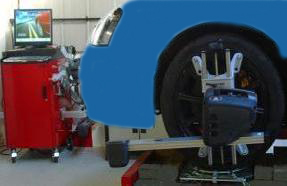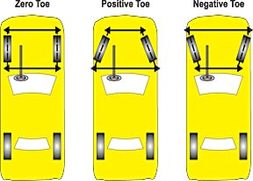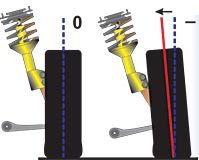Automotive Front-end Alignments

This page is about front-end alignments and why it is so hard to get a good one. Even though this is not a do it yourself auto repair, it’s good to know what you’re up against to actually receive a quality wheel alignment.
Many DIY car mechanics (myself included) will replace the front-end parts that are required, and then take the vehicle in for the alignment.
This is a good plan, but you want to make sure the auto repair shop follows through by setting all adjustable angles.
On my short list of things to ask for when you pay for a wheel alignment is to get before and after printouts. All modern day alignment racks have vehicle specifications and printers built into the equipment.
The print out will have the specifications or the factory wheel alignment settings that the vehicle should have. Also on the print out will be the before readings for Castor, camber, and toe in settings. And last but not least, the final readings after all the adjustments are done and locked.
Even if you do not have experience with alignment settings, you should still ask for these before and after prints. When you begin to study the final settings you can compare them to the factory specifications to be assured they are within tolerances.
More often than not, when this request is made, you will find that the technician will go the extra mile to make sure his educated customer is satisfied with the alignment.
Signs of poor front end alignment

Tire wear is one indication that your alignment may have become out of specifications. If you have feathered tire wear evenly on both front tires. This is an indication that the front toe settings are out of the factory specifications.
The same goes for the rear tires. Some vehicles have adjustable rear toe settings, and if these are out they can also cause feathered rear tire wear as well as dog tracking.
Another good way to check for dog tracking, which is an indication of the thrust angle alignment being out of specifications, is to have someone follow you down the road.
This is a good way to see if the vehicle is tracking straight. Dog tracking is highly visible from the vehicle that follows directly behind you.
If you’re camber is out of specification, the most common tire wear indication would be inside or outside tread wear. This is where either the inside rows of tread or outside rows are worn much further than the other. Note that if this condition is severe tire replacement may be required in order to correct the camber specifications.
Wheel alignment settings
The Castor alignment settings are not known for wearing tires. Where this setting is most important is the characteristics of the steering such as wondering and pulling.
My automotive instructor always used the example of shopping carts front wheels when talking about Castor. The Castor setting is also what is responsible for returning the front wheels to center automatically when coming out of a turn.
If you come out of a turn and the wheels have to be straightened manually. This setting will need to be adjusted. Also note that Castor can be affected by worn or loose strut rods or control arm bushings.

It’s not easy to get a good quality front-end alignment. The low price of the service either requires the shop to up sell front end parts or receive extra labor for elongating strut holes to adjust camber or other types of modifications to make a profit. Although the focus should be to bring the vehicle within factory specifications.
When the customer declines the additional repairs, and only wants to pay for the alignment special, the technician will set the toe and let it go. Your steering wheel may be straight, but you will have to keep an eye on your tire wear for several months after the alignment service is completed.
Also note that it is recommended to rotate your tires every 6,000 miles. This is because the front steering tires will have a lot more wearing than the fixed position rear tires in most cases.
Keeping up on your tire rotation may reduce the frequency that you will have to replace those tires. In the same way that performing a proper chassis lubrication can save replacement of front end parts.
So don’t be afraid to ask for your alignment printout and learn about the three major wheel alignment settings, which include Castor, camber, and toe. I have a dedicated section about car suspension on my other site that can help you learn more about front-end parts and diagnosis. The shop will respect you for knowing your stuff and your chances for getting a high quality front-end alignment increases.

